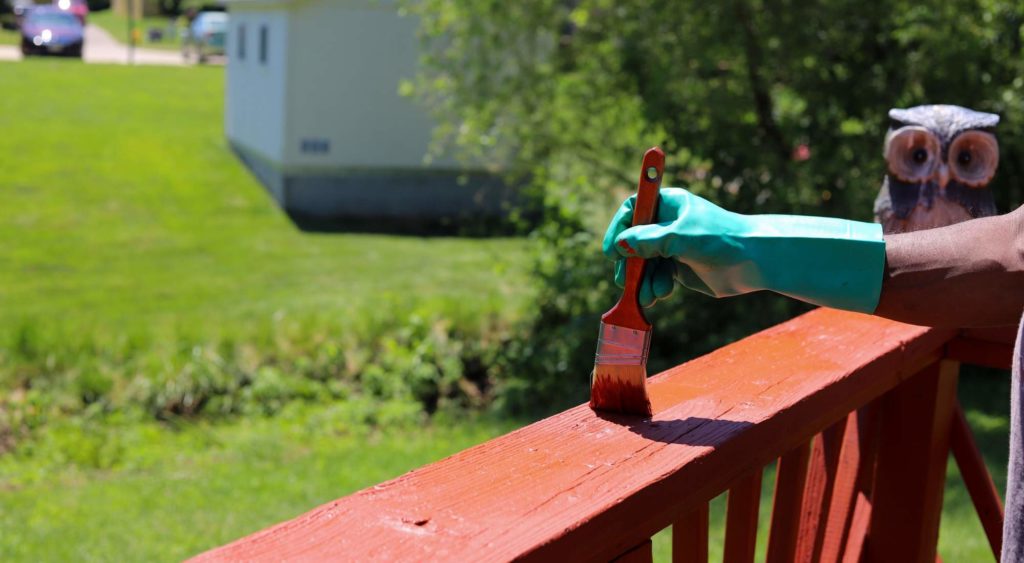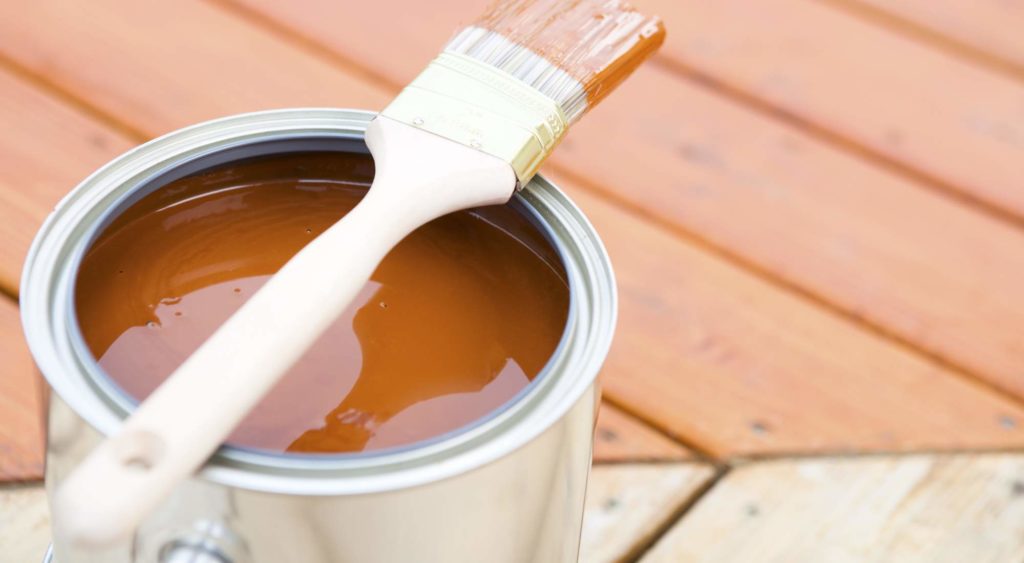Deck season is here and you cannot wait to get out and enjoy some fun and sun on your deck! You begin your yearly maintenance ritual by sweeping the leaves off your deck when you notice the paint or stain is beginning to flake. Then you also notice the color is also a bit faded and some of the wood has begun to gray.
It was inevitable, but the time has finally come: you need to refinish your deck.
It seems like there are so many options and you have so many questions. Is it better to paint or stain a deck? What lasts longer on a deck, paint or stain? What kind of paint or stain should I use on my deck?
The option that is best for you and your deck will vary based on a few defining factors. Keep reading to find out what to consider when you decide whether to paint or stain your deck.
Table of Contents
- How To Know When It’s Time To Paint or Stain Your Deck
- Know the Different Types of Paint and Stains Available Before You Start
- 6 Factors To Consider When Deciding Between Paint vs. Stain for Your Deck
- Which Is It? Is It Better to Paint or Stain a Deck?
- Is It Okay Not To Paint or Stain a Deck?
- Ready To Paint or Stain Your Deck? Call the Pros at Two Brothers Painting in Portland, OR
How To Know When It’s Time To Paint or Stain Your Deck
Refinishing your deck is crucial to providing preventative care and extending its lifespan.
A well-maintained deck not only adds to the beauty of your home, it also increases your property value. It is obvious to any deck owner that refinishing your deck is inevitable but how do you know when it is time to repaint or restain your deck?
Signs that your deck needs to be refinished:
- Peeling, flaking, or bubbling surfaces: Paint or stain that is peeling or flaking indicates that the paint or stain is lifting. Paint/stain protects the wood from moisture absorption. Bubbling paint is an indicator that moisture has seeped through the paint causing a loss of adhesion between the paint and wood.
- Graying or weathered wood: Discolored wood or graying wood is an indicator that time and environmental elements have weathered the wood of your deck.
- Absorbing water: Deck paints/stains are designed to seal the wood and deflect water absorption. Decks that absorb water can mildew, mold, or rot. Water should ‘bead off’ when coming in contact with your deck.
Certain factors lead to some decks needing more TLC than others. How often you should restain or repaint your deck can depend on:
- UV exposure: Ultraviolet (UV) ray exposure breaks down the chemical bonds in stains and paints causing fading or discoloration. Decks exposed to more sunlight and higher UV rays will need to be repainted/restained more often than decks hidden by the shade.
- Climate: Exposure to humid/wet climates might require your deck to need refinishing more often.
Know the Different Types of Paint and Stains Available Before You Start
Deck Paints
Exterior paint is different from interior paint, so please leave that extra can of paint from when you painted your living room in the garage.
Exterior paints used on decks are designed to handle horizontal and high-traffic surfaces as well as exposure to outdoor elements. Deck paint is water resistant and some deck paints are made with ‘non-slip’ additives.
Deck paints can be oil-based or water-based. This difference is the type of solvent used. Solvent is the liquid component of the paint that evaporates when the paint dries. Oil-based paints use a mineral solvent. Water-based paints, like latex or acrylic, use water as the solvent.
A painted deck can typically last 5-10 years before it needs to be repainted.
Oil-Based Paint
Oil-based paint is highly durable and absorbs into the wood providing excellent protection from water and scratches. It works well for highly trafficked areas like a deck.
One disadvantage of oil-based paint is that it is very hydrophobic, so water may eventually become trapped in the wood and cause a bubbled surface. Oil-based paint is the easier option regarding application but removal is more difficult.
Latex Paint
Latex deck paint is a water-based paint that responds well to high UV exposure. It is more resistant to flaking and peeling than acrylic. Latex paint is ideal for humid climates and is mold/mildew resistant.
It is easier to remove than oil-based paint, but if you lack the skills of a professional painter it can be harder to evenly apply, causing streaks and unevenness. Latex paint also comes in a wider variety of colors allowing you to have more options to choose from.
Acrylic Paint
Acrylic deck paint is the most affordable exterior paint. As a water-based paint, it works well in more humid climates and it is mildew resistant. It is not as durable as oil-based or latex paint, but in the right climate, it can last just as long before it needs to be reapplied.
Acrylic paint should not be used on decks exposed to temperatures lower than 40 degrees Fahrenheit because low temperatures cause acrylic paint to become brittle and chip away.
Deck Stains
If you prefer a more natural look on your wooden deck, stains provide a nice finish that accentuates the natural beauty and grain of the wood. Deck stains allow the wood to easily breathe while providing excellent protection against water, wear and tear, and humid climates.
Deck stains, like deck paints, can be water-based or oil-based. Oil-based stains, like semi-transparent and transparent stains, are easier to apply but can require a new coat every other year.
Water-based stains, like solid stains, last longer (3-5 years) but require more skill and precision during application. Be sure to contact a professional if you are unsure how to stain exterior wood.
Solid Stain
Solid stain reacts similarly to paint as it is fully pigmented and sits on top of the wood, but unlike paint, it is highly permeable and allows the wood to breathe.
Because it sits on top of the grain it will hide imperfections and signs of aged wood better than transparent stains. Solid stains protect wood against mold and mildew better than semi-transparent/transparent stains.
Solid stains offer more protection from the climate and UV exposure but are more prone to chipping. You can expect your solid stain to last approximately 3 to 5 years.
Semi-Transparent Stain
Semi-transparent stain provides coverage while using hue to bring out the beauty in the grain of the wood. It is a good stain for decks that have minor weathering or imperfections, as semi-transparent stains are light and do not conceal much. Semi-transparent stains are more durable than transparent stains, but less durable than solid stains or paint.
Semi-transparent deck stains have more pigment so they are less prone to fading and may need to be reapplied less frequently than transparent stains.
Transparent Stain
Transparent stains provide protection but very little concealment. This type of stain is best suited for well-maintained decks that are exposed to very little sunlight.
Transparent stain seeps deep into the pores of the wood, allowing it to be pressure-washed without the worry of stripping the stain. Transparent stains are less prone to cracking or peeling. When it is time to reapply, you can easily put on another coat.
6 Factors To Consider When Deciding Between Paint vs. Stain for Your Deck
#1: Cost
Stain is generally more budget-friendly than paint, but keep in mind the additional cost of maintenance, reapplication, and removal. You might find yourself having to apply a maintenance coat on your deck more often if you use certain paints/stains over others.
#2: Aesthetic
Does paint or stain look better on a deck? This answer relies on personal preference and the condition of your deck. Paints or solid stains work better at hiding marred and discolored wood.
But what if the wood in your deck still has its natural beauty or nice grain? You can further show off your wooden deck by using a semi-transparent or transparent stain that protects the wood while accommodating your tastes for a natural look.
#3: Color Choice
You might want your deck to match the trim or siding of your home. Or maybe you want it to be a nice eye-catching statement piece sporting an unusual color like teal or green.
If that is your taste, deck paint will provide more variety when it comes to color. Deck stains come in more natural colors intended to add a subtle hue to your deck.
#4: Application Process
Water-based paints and stains are generally harder to apply than oil-based paints or stains, but deck stains are generally easier to apply than deck paints.
If you are repainting your deck, you must remove old peeling and chipped paint/stain via light sanding before repainting or restaining. For maintenance repainting/restaining, you might not need to restain but you should repaint/restain the entire deck to ensure an even coating. Paints may require a primer if there isn’t one included in the product.
#5: Longevity
Water-based deck paint and solid stains will generally last longer than transparent stains or oil-based deck paint.
Exterior paint can last 5-10 years before it needs to be reapplied. Solid stains can last 3 to 5 years if applied correctly, and transparent/semi-transparent stains may need to be reapplied every other year.
You must consider the climate when choosing a stain or paint because certain stains and paints are designed to work better in specific climates and will deteriorate quicker in others. Professionally applied paints and stains may last longer than DIY home jobs.
#6: Maintenance
A painted deck is easier to clean than a stained deck. Stained decks result in a matte surface that can make it more difficult to sweep than the slick surface of painted decks.
A stained deck is more amenable to pressure washing than a painted deck, but it is important that you implement a low setting and distance to avoid stripping the stain.
Which Is It? Is It Better to Paint or Stain a Deck?
The answer to “Is it better to paint or stain a deck?” can vary based on personal preference, the state of the wood, and climate. So it is important to consider these pros and cons when making the final decision.
If you are uncertain about what is best for you and your deck, you can always count on a professional to do that job right. Two Brothers Painting is here to help with all of your exterior painting needs.
Pros and Cons of Painting a Deck
Keep in mind some of the factors mentioned above when considering the pros and cons of painting your deck.
Pros of painting your deck:
- Deck paint typically lasts longer and is more durable against wear and tear.
- Paint provides a better protective barrier to your deck, fighting off moisture and UV rays more successfully.
- A painted deck provides a slick surface that is easier to clean.
- Deck paint lasts longer than stain.
- You can paint over a stained deck.
Cons of painting your deck:
- A painted deck loses its natural appearance and texture.
- Paint can be harder to remove and may require more time and resources for removal.
- Paint may hide indicators (mold, rot, mildew) that it is time to replace your deck.
- A painted deck is more slippery than a stained deck.
Pros and Cons of Staining a Deck
Think about the factors mentioned above when considering the pros and cons of a stained deck.
Pros of staining your deck:
- Stain dries faster than paint, allowing you to apply more coats in a shorter amount of time.
- You do not have to apply primer before staining your deck.
- It is cheaper and more cost-effective to stain your deck.
- A stained deck has a less slippery surface (good to keep in mind if you have a wooden deck for your above-ground pool).
Cons of staining your deck:
- Deck stain does not hide imperfections as well as paint.
- More coats are required to ensure moisture control and UV protection.
- A painted deck may be harder to clean.
- Stain does not last as long as paint.
Is It Okay Not To Paint or Stain a Deck?
Is it okay to forgo painting or staining a deck? Paints and stains are essential to providing a protective barrier for the wood. Exposed wood is highly prone to UV damage, wear-and-tear damage, mold/mildew, rot, and pests.
Protecting the wood is essential to a long-lasting deck as wood exposed to the elements may lead to structural safety issues. Remember: it is cheaper to invest in preventative measures and maintenance than it is to remove and/or replace a deck.
If you are unsure about whether paint or stain would best suit you and your deck, you can always count on a professional! Professional application of exterior paints and stains will ensure the longevity and quality of your deck. It is also cheaper to trust the professionals who get it done right the first time than to have to invest money in restaining or repainting after an improper DIY job.
Ready To Paint or Stain Your Deck? Call the Pros at Two Brothers Painting in Portland, OR
Summer may be here but it is never too late to spruce up your deck!
Two Brothers Painting has over 150 years of combined professional experience and we are here to help you get your deck looking its best. Portland needs professionals who understand the climate and know how to combat the problems it presents when it comes to exterior paint jobs.
Other services our trusted professionals offer:
- Exterior home painting
- Historic home painting
- Pressure washing
So if you’re in the Portland Metro area and you’re ready to paint or stain your deck, schedule an estimate now.





